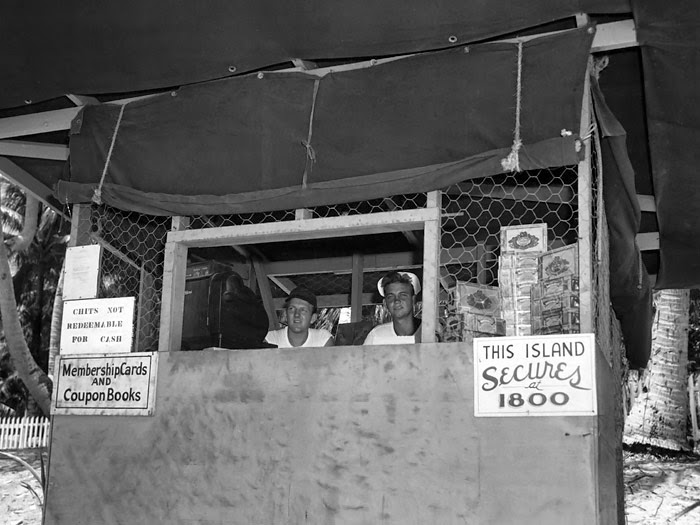Within a few days after the Ulithi Atoll in the Caroline Islands was taken on September 20, 1944, advanced portions of the Navy's mobile service force, Service Squadron 10, began arriving to create an expansive anchorage for the fleet. My father's repair ship Hector, was one of the first ships of the squadron to arrive and begin initial work in the lagoon.
A few days later, a naval construction battalion of "Seabees" arrived to construct an airstrip on Falalop Island. The Seabees also went to work completing a number of uniquely designed pontoon piers, instantly increasing the harbor's function and capacity.
Within days, 6,000 ship fitters, artificers, weldors, carpenters, electricians, and other servicemen of Service Squadron 10 arrived aboard repair ships, destroyer tenders, and floating dry docks. Together they transformed Ulithi into the largest naval base in the world. It was an incredible feat.
A few days later, a naval construction battalion of "Seabees" arrived to construct an airstrip on Falalop Island. The Seabees also went to work completing a number of uniquely designed pontoon piers, instantly increasing the harbor's function and capacity.
Within days, 6,000 ship fitters, artificers, weldors, carpenters, electricians, and other servicemen of Service Squadron 10 arrived aboard repair ships, destroyer tenders, and floating dry docks. Together they transformed Ulithi into the largest naval base in the world. It was an incredible feat.
 |
| Sailors arrive at Mog Mog Landing |
In additional to other engineering and construction projects, crews also built a much-needed fleet recreation facility for Sailors and Marines who had been fighting and working nearly non-stop for months.
The tiny 60-acre island of Mog Mog was selected for the facility. It was at first an unsuitable area, swampy and mosquito- and insect-infested. But the swamp soon was cleared and filled in with coral, creating a spacious recreation area.
Construction began on this date in 1944. Several venues for sports, a bandstand, and beverage storage were provided. When completed in January 1945, the center could accommodate 8,000 men and 1,000 officers daily. A 1,200-seat theater, including a 25-by-40-foot stage with a Quonset hut roof was also created, along with a 500-seat chapel.
Construction began on this date in 1944. Several venues for sports, a bandstand, and beverage storage were provided. When completed in January 1945, the center could accommodate 8,000 men and 1,000 officers daily. A 1,200-seat theater, including a 25-by-40-foot stage with a Quonset hut roof was also created, along with a 500-seat chapel.
 |
The intersection of "Hollywood and Vine,"
near the landing area at Mog Mog
|
 |
| Refreshment Stand on Mog Mog Island |
 |
| Beach Liberty |
For several months in 1944-1945, Mog Mog would have been the only land that most sailors of the Pacific Fleet would have set foot on. As ships returned to Ulithi for replenishment, crewman were allowed a few hours ashore. Landing craft picked up the men from their ships anchored in the harbor, dropped them off for an afternoon ashore, then returned them to their vessels by early evening.

No comments:
Post a Comment